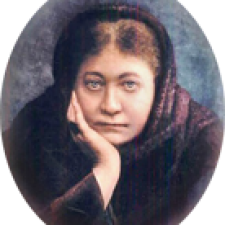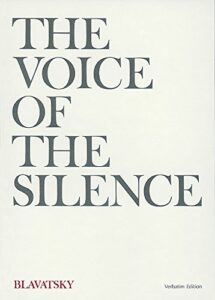Voice Of The Silence
Translated from the Book of the Golden Precepts, which shares a common origin with the Stanzas of Dzyan of The Secret Doctrine, the rules and ethics presented in the Voice contrast the two paths of spiritual attainment: the one pursued by those seeking knowledge for their own enlightenment; the other chosen by those whose aspirations are prompted by compassion for all.
“Here is real Mahayana Buddhism.” – D.T. Suzuki
“I believe that this book has strongly influenced many sincere seekers and aspirants to the wisdom and compassion of the Bodhisattva Path.” -14th Dalai Lama
From the Chinese Buddhist Research Society Edition of 1927.
“The present reprint has been undertaken largely because the original edition has been out of print for many years, while those issued since H. P. B.’s death in 1891 contain errors and even, in some cases, deliberate alterations and omissions. Our aim has, therefore, been to restore to its original integrity the most beautiful and poetical volume of H. P. Blavatsky’s great literary bequest. In so doing we have not only striven for textual accuracy, but have sought to reproduce, as closely as local facilities permitted, the size, cover and make-up of the original. The type is a little larger, but the pagination is exactly the same.
The circumstances under which the opportunity arose to effect tis work of restoration were singularly fortunate. Reaching Peking (Beijing) in December, 1925, after studying for seven years in India, we were privileged to come into close touch with H. H. The Tashi Lama, who had left Tibet in 1924 on a special mission to China and Mongolia. As members of his Order, part of the work we undertook at his request for Buddhism was the present reprint, as the only true exposition in English of the Heart Doctrine of the Mahayâna and its noble ideal of self-sacrifice for humanity.
During many years of study and initiation in Tibet, H. P. B. spent a considerable time at Tashi-lhum-po, and knew the predecessor of the present Tashi Lama very well. The Golden Precepts here translated by her for the use of her pupils describe the processes of meditation and self-conquest by which the earnest disciple may hope in the course of many incarnations to become a Master of Wisdom, a Nirmânakâya who follows the Buddha on the Path of Compassion for suffering humanity, and remains “unselfish to the endless end.” That such exalted beings exist as living men is known to all Oriental mystics who belong to the various schools of Yoga to which H. P. B. refers in her Preface. In China and Mongolia, as in India, we find their existence taken for granted by those who have any knowledge of the Esoteric Philosophy.
All the Tibetan terms and references have been checked with the assistance of members of the Tashi Lama’s suite, and our Chinese friends have also given us every assistance. It is with very great satisfaction that we publish this edition under the auspices of the Peking (Beijing) Buddhist Research Society, who reognise in it the highest and most sacred teachings of their own “contemplative” schools. It was not until we came in contact with Chinese and Tibetan Buddhist that we obtained this striking confirmation of the truth and value of H. P. Blavatsky’s work.
The little book is now, therefore, reprinted with the strongest and most authoritative Tibetan and Chinese endorsement. A few printer’s errors in the original have been corrected, but nothing else has been altered. In response to the requests of many students we have ventured to add some notes and comments on points which called for explanation in the course of study, together with a good deal of information collected from Chinese and Tibetan sources. Having carfully verified the text, plates have been cast to as to ensure the accuracy of any future impressions.”
Peking (Beijing), China, May 1927
Alice Leighton Cleather
(One of H.P. B’s Pupils)
Basil Crump.
______________________________
From an addendum letter of B. T. Chang (interpretor and one of the secretaries to the Tashi Lama.)
“Having appended a Chinese note to the end of this book, I am further requested by the editors to write a few lines in English. I deem it an honour and a privelege to do so, and offer herewith a recapitulation of what I have set forth in Chinese.
Since its translation into English from the Tibetan by Madame H. P. Blavatsky, in 1890, this little book, the gem of Buddhist teachings, as enjoyed a wide circulation among Europeans and American interested in Buddhism. There is, therefore, little need for me to recommend it to foreign readers, except to point out that what is embodied in it comprises a part of the teachings of the Esoteric School.
What strikes me most in the opening chapter is the sentence: “The Mind” – i.e., the Lower Mind – “is the Great Slayer of the Real. Let the Disciple slay the Slayer.” These are the words that sound the keynote of the Buddha’s teachings. Time and again the Buddha commands his disciples to suppress the activities of the Lower Mind for the benefit of the Higher Self, because anything and everything in the exterior Universe consists of nothing but sense-impressios created by one’s Lower Mind, which is apt to lead the aspirant astray. The disciple should not seek truth elsewhere, but should try to find it within himself. He will then be able to hear the Voice of the Silence or, in the language of the Chinese Buddhists, the “Divine Voice of the Self”. Traditions syas that Avalokiteshwara attained the state of a Bodhisattwa after hearing the Divine Voice of the Self. This doctrine is greatly revered by the Chinese, who got it from the Sanskrit.
Madame Blavatsky had a profound knowledge of Buddhist philosophy, and the doctrines she promulgated were those of many great teachers. This book is like a call to men to forsake desire, dispel every evil thought, and enter the true Path. In Fragment II the passage whick likens the Mind to a mirror sounds exactly like what is stated in the Chuan Têng Lu, a Chinese Buddhist work of renown. This allegory also may have its own origin in some Sanskrit work, from which it found its way into both Chinese and Tibetan Buddhist works; or, more probably, the Tibetans have derived it from a Chinese source.
In this materialistic world the majority of people, especially Europeans and American, always absurdly regard Buddhism as a system of philosophy which advocates nothing but passivity and inactivity. A perusal of this book will certainly dispel such mistaken notions from the minds of even the most skeptical.
It has been suggested to me that for the benefit of the Chinese Buddhist, this work should be translated into Chinese. I quite agree with this idea, but pressure of work has hitherto prevented me from writing more than these few lines. Although they form an inadequate recognition of the merit of the book, I offer them because of my great reverence for its teachings; and I hope to be able to undertake the translation at some future time.
Peking, July, 1927
B. T. Chang
Preface to the Voice of The Silence
Voice of The Silence – Fragment I


